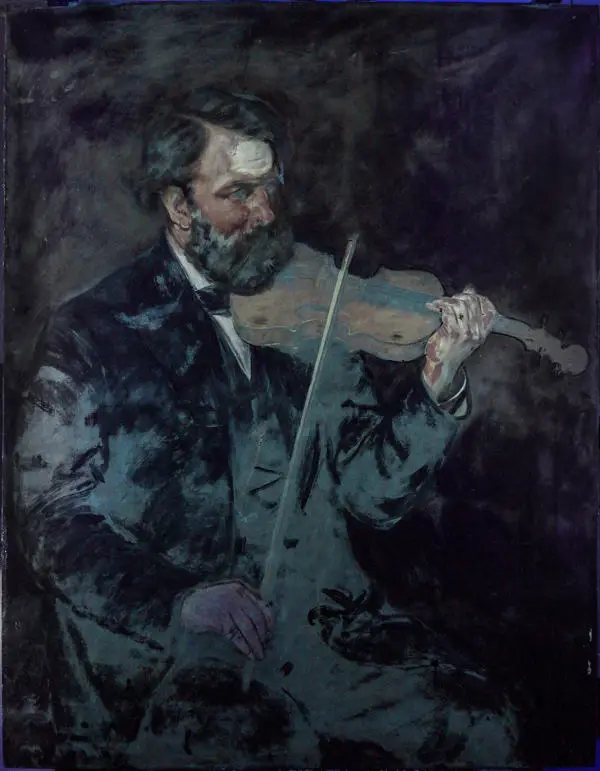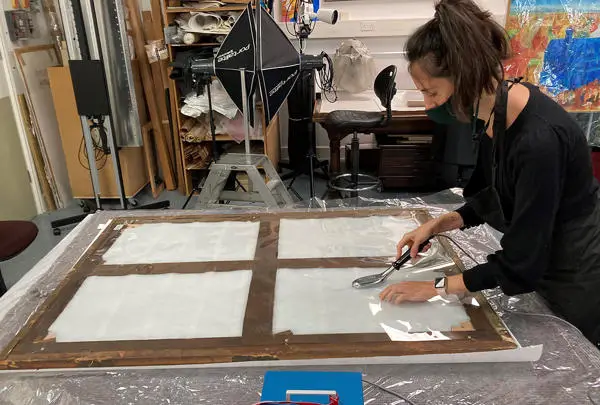
The conservation treatment of the ‘Portrait of Doctor Joseph Joaquim’ c.1876, by James Archer was carried out by Luz Vanasco during her postgraduate internship at the Guildhall Art Gallery. The painting needed conservation work before it was displayed as part of the ‘Inspired!’ exhibition.
This oil painting on canvas had a very pronounced craquelure, with unstable areas where the paint layers were lifting from the canvas and were therefore at risk of paint loss. Moreover, the painting was aesthetically compromised due to the presence of a very glossy and discoloured varnish which was exacerbated by the wide network of hairline cracks. Therefore, the painting required conservation work to prevent further damage and to return the picture to a displayable condition.

'Portrait of Doctor Joseph Joachin' before conservation treatment
Research and technical examination were carried out at the same time to further understand Archer’s way of working, the material history of the painting and its condition, all of which determined the treatment proposal.
Research
Archer used to date and sign most of his paintings, usually using a monograph with an arrow. However, this painting is unusual in that bellow the signature there are two dates: 1874 and 1902.

Detail of the monograph with the two dates
Surprisingly, infra-red photography revealed a second separate monograph dated 1878 which had been completely painted out by Archer and is now invisible to the naked eye.
Research is still being carried out to figure out why Archer painted this portrait in the first place, what was the relationship between the artist and the sitter, why did Archer keep the painting for such a long time, and when and why did he rework it. However, it is possible to hypothesize that the three different dates on the portrait of Joachim relate to significant points in the painting’s timeline. The painting was first painted in 1874 when it was exhibited in the British section of the International Exhibition held in Philadelphia. Afterwards, in 1878, Archer exhibited the painting at the Royal Academy. Finally in 1902 the painting was donated to the Guildhall School of Music.
Examination and cleaning
By exposing the painting to ultraviolet (UV) radiation, some materials become fluorescent. This is very useful to conservators as it helps to further understand the superficial layers of the painting, such as varnishes or overpaint. Before the treatment, the painting presented an upper layer of general bluish florescence that corresponded to the discoloured varnish, probably applied in 1959 during its last recorded treatment. However, it was also possible to see a greenish, localised fluorescence in the layer underneath the varnish. It was therefore decided to do a very controlled cleaning, removing only the top layer of varnish, which was safely carried out using gelled solvents.

Painting seen under UV radiation, before the removal of the varnish
Seen under UV after the cleaning, it was possible to see the greenish fluorescing areas alongside dark non-fluorescing areas that probably correspond to later painting applied by the artist when it was reworked.

Painting seen under UV radiation, after the removal of the varnish
Consolidation
Unstable flaking paint was secured with an adhesive and gently put back to plane and dried with a heated spatula.
Filling and Retouching Losses
Once the painting was cleaned and stable, a new varnish was applied by brush. Areas with paint loss, were filled with a chalk putty and retouched with a mixture of dry pigments and a synthetic varnish medium, mimicking the surrounding paint.
Backing
A polyester wadding backing was fitted next to the back of the canvas to provide it with some structural support while buffering environmental fluctuations that could be detrimental for the painting. This will help prevent further damage to the fragile aged canvas support and to the paint layer.

Luz Vanasco applying the wadding to the back of the painting
The painting was last on display at the Guildhall School of Music in the 1970s and has never been on display at the Guildhall Art Gallery. After treatment, the painting is now ready to be enjoyed by the public for the first time as part of the ‘Inspired!’ exhibition.




